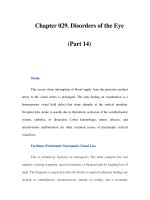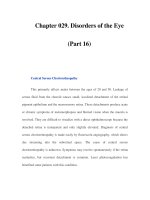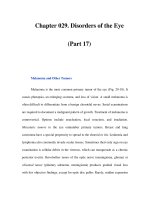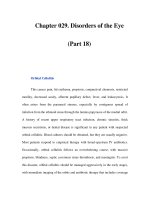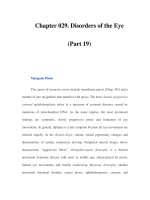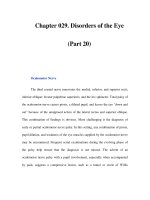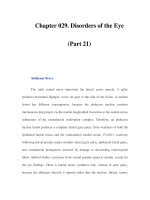Chapter 029. Disorders of the Eye (Part 23) pptx
Bạn đang xem bản rút gọn của tài liệu. Xem và tải ngay bản đầy đủ của tài liệu tại đây (17.45 KB, 7 trang )
Chapter 029. Disorders of the Eye
(Part 23)
Parinaud's Syndrome
Also known as dorsal midbrain syndrome, this is a distinct supranuclear
vertical gaze disorder from damage to the posterior commissure. It is a classic sign
of hydrocephalus from aqueductal stenosis. Pineal region tumors, cysticercosis,
and stroke also cause Parinaud's syndrome. Features include loss of upgaze (and
sometimes downgaze), convergence-retraction nystagmus on attempted upgaze,
downwards ocular deviation ("setting sun" sign), lid retraction (Collier's sign),
skew deviation, pseudoabducens palsy, and light-near dissociation of the pupils.
Nystagmus
This is a rhythmical oscillation of the eyes, occurring physiologically from
vestibular and optokinetic stimulation or pathologically in a wide variety of
diseases (Chap. 22). Abnormalities of the eyes or optic nerves, present at birth or
acquired in childhood, can produce a complex, searching nystagmus with irregular
pendular (sinusoidal) and jerk features. This nystagmus is commonly referred to as
congenital sensory nystagmus. It is a poor term, because even in children with
congenital lesions, the nystagmus does not appear until several months of age.
Congenital motor nystagmus, which looks similar to congenital sensory
nystagmus, develops in the absence of any abnormality of the sensory visual
system. Visual acuity is also reduced in congenital motor nystagmus, probably by
the nystagmus itself, but seldom below a level of 20/200.
Jerk Nystagmus
This is characterized by a slow drift off the target, followed by a fast
corrective saccade. By convention, the nystagmus is named after the quick phase.
Jerk nystagmus can be downbeat, upbeat, horizontal (left or right), and torsional.
The pattern of nystagmus may vary with gaze position. Some patients will be
oblivious to their nystagmus. Others will complain of blurred vision, or a
subjective, to-and-fro movement of the environment (oscillopsia) corresponding to
their nystagmus. Fine nystagmus may be difficult to see upon gross examination
of the eyes. Observation of nystagmoid movements of the optic disc on
ophthalmoscopy is a sensitive way to detect subtle nystagmus.
Gaze-Evoked Nystagmus
This is the most common form of jerk nystagmus. When the eyes are held
eccentrically in the orbits, they have a natural tendency to drift back to primary
position. The subject compensates by making a corrective saccade to maintain the
deviated eye position. Many normal patients have mild gaze-evoked nystagmus.
Exaggerated gaze-evoked nystagmus can be induced by drugs (sedatives,
anticonvulsants, alcohol); muscle paresis; myasthenia gravis; demyelinating
disease; and cerebellopontine angle, brainstem, and cerebellar lesions.
Vestibular Nystagmus
Vestibular nystagmus results from dysfunction of the labyrinth (Ménière's
disease), vestibular nerve, or vestibular nucleus in the brainstem. Peripheral
vestibular nystagmus often occurs in discrete attacks, with symptoms of nausea
and vertigo. There may be associated tinnitus and hearing loss. Sudden shifts in
head position may provoke or exacerbate symptoms.
Downbeat Nystagmus
Downbeat nystagmus occurs from lesions near the craniocervical junction
(Chiari malformation, basilar invagination). It has also been reported in brainstem
or cerebellar stroke, lithium or anticonvulsant intoxication, alcoholism, and
multiple sclerosis. Upbeat nystagmus is associated with damage to the pontine
tegmentum, from stroke, demyelination, or tumor.
Opsoclonus
This rare, dramatic disorder of eye movements consists of bursts of
consecutive saccades (saccadomania). When the saccades are confined to the
horizontal plane, the term ocular flutter is preferred. It can occur from viral
encephalitis, trauma, or a paraneoplastic effect of neuroblastoma, breast
carcinoma, and other malignancies. It has also been reported as a benign, transient
phenomenon in otherwise healthy patients.
Further Readings
Albert DM et al (eds):
Albert
and Jakobiec's Principles and Practice
of Ophthalmology
, 3d ed. Philadelphia,
Saunders, 2007
Balcer LJ et al: Natalizumab
red
uces visual loss in patients with
relapsing multiple sclerosis. Neurology
68:1299, 2007 [PMID: 17438220]
Gariano RF, Gardner TW:
Retinal angiogenesis in development
and disease. Nature 438:960, 2005
[PMID: 16355161]
Rosenfeld PJ et al: Ranibizumab
for neovascular age-
related macular
degeneration. N Engl J Med 355:1419,
2006 [PMID: 17021318]
Rutar T et al: Ophthalmic
manifestations of infections caused by
the USA300 clone of community-
associated methicillin-
resistant
Staphylococcus aureus
.
Ophthalmolog
y 113:1455, 2006
[PMID: 16766029]
Bibliography
Alaedini A et al: Detection of anti-ganglioside antibodies in Guillain-
Barré
syndrome and its variants by the agglutination assay. J Neurol Sci 196:41, 2002
[PMID: 11959155]
Arnold AC: Evolving management
of optic neuritis and multiple sclerosis.
Am J Ophthalmol 139:110, 2005
Foster CS et al (eds):
Smolin and Thoft's The Cornea: Scientific
Foundations and Clinical Practice
, 4th ed. Philadelphia, Lippincott Williams &
Wilkins, 2004
Gragoudas ES et al: Pegaptanib for neovascular age-
related macular
degeneration. N Engl J Med 351:2805, 2004 [PMID: 15625332]
Hatter S et al: Melanopsin-
containing retinal ganglion cells: Architecture,
projections, and intrinsic photosensitivity. Science 295: 1065, 2002
Kanski JJ: Systemic Diseases and the Eye. St Louis, Mosby, 2001
Leibowitz HM: The red eye. N Engl J Med 343:345, 2000 [PMID:
10922425]
Leigh RJ, Zee DS: The Neurology of Eye Movements
, 4th ed. Oxford,
Oxford Univ Press, 2006
Miller NR et al (eds): Walsh and Hoyt's Clinical Neuroophthalmology
, 6th
ed. Philadelphia, Lippincott Williams & Wilkins, 2005
Neitz M, Neitz J: Molecular genetics of color vision and color vision
defects. Arch Ophthalmol 118:691, 2000 [PMID: 10815162]
Riordan-Eva P, Whitcher J: Vaughn and Asbury's General Ophthalmology
,
16th ed. New York, Lange Medical Books, 2004
Ryan SJ et al (eds): Retina, 4th ed. St Louis, Mosby, 2005
Spencer WH (ed): Ophthalmic Pathology. An Atlas and Textbook
, 4th ed.
Philadelphia, Saunders, 1996
Tayebeh R et al: Adult-onset primary open-
angle glaucoma caused by
mutations in optineurin. Science 295:1077, 2002
Trobe JD: The Neurology of Vision
, Univ Michigan Med School
(Contemporary Neurology Series 60), 2001

